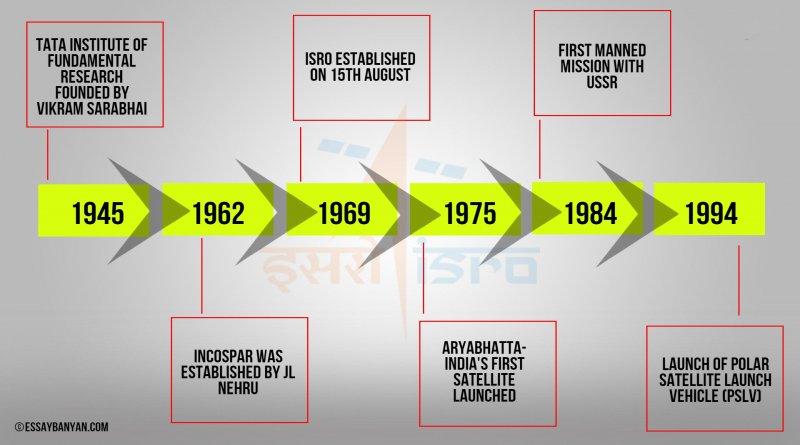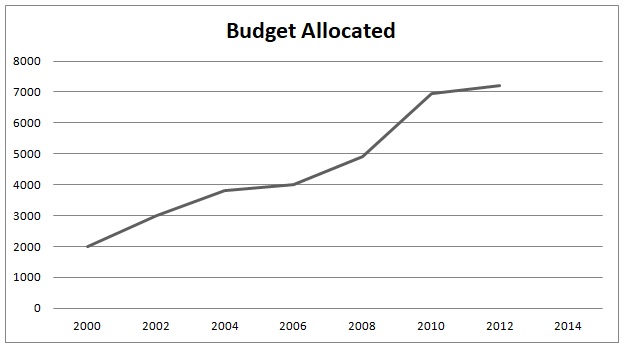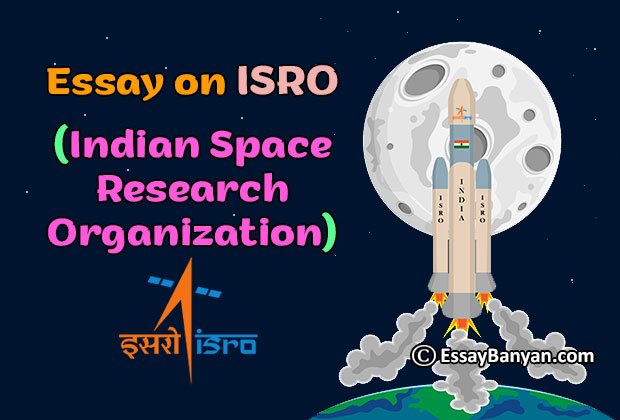ISRO stands for Indian Space Research Organization; it is a space agency that comes under the Department of Space (DOS). ISRO is known for conducting economical programs and is responsible for managing space affairs in India. One of the main achievements is conducting a successful landing on Mars on the first attempt also being the least expensive Mars Mission in the world. ISRO is also responsible to carry out communication satellites and is supposed to work with DRDO to watch out for the security of India.
Short and Long Essay on ISRO in English
Here is a long essay mentioning the history and importance of ISRO to India.
10 Lines Essay on ISRO (100-120 Words)
1) The space-related affairs of India are managed by an agency known as ISRO.
2) ISRO (Indian Space Research Organization) was set up on 15 August 1969.
3) The headquarters of ISRO reside in Bangalore.
4) ISRO’s current serving chairman is Shri S. Somanath (2022).
5) Aryabhatt is India’s first satellite developed by ISRO.
6) ISRO has discovered two moon missions.
7) DoS or the Department of Space is responsible for monitoring and managing ISRO.
8) Recently, ISRO has successfully completed Mars Mission.
9) IRS, INSAT, GAGAN, etc are some pride projects of ISRO.
10) ISRO holds 5 launch vehicles out of which three are operational launch vehicles.
Long Essay on Indian Space Research Organization – 1300 Words
Introduction
ISRO is also called Bhartiya Antariksh Anusandhan Sangathan in Hindi. It is directly seen by the Prime Minister of India. The current chairman, Dr. Kailasavadivoo Sivan also known as K Sivan is also an executive member of the Department of Space (DOS). ISRO holds the record for being one of the agencies with Full Launch capabilities, the ability to launch extraterrestrial missions and can operate a big cortege of artificial satellites.
ISRO boasts 5 launch vehicles namely Satellite Launch Vehicle (SLV), Augmented Satellite Launch Vehicle (ASLV), Polar Satellite Launch Vehicle (PSLV), Geosynchronous Launch Vehicle (GSLV) and Geosynchronous Launch Vehicle Mark III (GSLV-MK III). Among those, 3 are operational launch vehicles which are mentioned below-
- PSLV – Stands for Polar Satellite Launch Vehicle, it is a third generation launch vehicle and was first launched in the year 1994. Till 2017, it has launched 257 satellites in which 48 are Indian satellites and 209 are foreign. It is well known for its successful launch of Mars Orbiter Spacecraft in 2013 and Chandrayan-1 in2008.
- GSLV – Also known as Geosynchronous Launch Vehicle Mark II (MKII) was launched first on 18th April 2001. Since then it has been in 13 missions and holds the record for having success in 4 missions consecutively.
- GSLV-MK III – Was chosen to launch the Chandrayan II and has the twice the capacity of GSLV MK II and was launched in the year 2014 for the first time.
History of ISRO
Earlier scientists like S.K. Mitra, C.V. Raman, and Meghnad Saha used to carry space programs. Later Vikram Sarabhai founded Physical Research Laboratory at Ahmedabad. Homi Bhabha established the Tata Institute of Fundamental Research in 1945.
In 1962, the urge of the Indian National Committee for Space Research (INCOSPAR) was established by PM Jawaharlal Nehru. Later in 1963 sounding rocket was launched from Thumba Equatorial Rocket Launching Station (TERLS). On 15th August 1969 Indian Space Research Organization (ISRO) was established.
One of the biggest landmarks was seen when ISRO sent its first satellite ‘Aryabhatta’ with a Soviet Rocket in the year 1975. Later, in the year 1982, Indian National Satellite (INSAT-1A) was launched. ISRO collaborated with the Soviet Union to conduct the first manned mission in 1984 in which Rakesh Sharma was a part of it.
In 1994, ISRO conducted the launch of Polar Satellite Launch Vehicle (PSLV), the third generation of launch vehicles. Moving to 2001, ISRO managed to successfully launch GSLV D1. ISRO stepped on the moon in the year 2008 and in 2014 ISRO managed to land on Mars.

Role of ISRO in the Advancement of India
ISRO’s role in the Advancement of India cannot be forgotten from Aryabhatta to NavIC. Here are some of the projects that became a landmark and helped India in modernization.
- IRS – the Indian Remote Sensing Satellite (IRS) is a series of Earth observation satellites from India. The IRS line provides remote sensing services and is the largest set of residential remote sensing satellites in use today in the world. They have a wide range of applications which are beneficial for different purposes.
- INSAT – The Indian National Satellite System (INSAT) is the Indian family of communication satellites. The project jointly includes DOS, DOT, MBI and Prasar Bharti. It is a multipurpose geostationary satellite helpful in different needs like telecommunications, broadcasting and research. These satellites have been put to good use by the Indian armed forces. GSAT9 or “SAARC Satellite” is a notable example of communication services to India’s small neighbors.
- GAGAN – GAGAN stands for GPS Aided GEO Augmented Navigation. It is a GPS Satellite Augmentation System working regionally; it has satellite communication and air traffic management plan for the aviation industry ‘civil Aviation. The Indian system SBAS, space Augmentation System.
Achievements of ISRO
India is prideful to have ISRO as it has given us many reasons to feel pride. ISRO has always delivered whenever India wanted to do something, ISRO never failed to surprise us. Be it the cheapest landing on Mars or finding water on Moon, ISRO has done many works. Here are some of the Achievements that ISRO must be proud of.
- Mars Orbital Mission (MOM) – The Mars Orbital Mission or Mangalyan is one of the biggest successes for ISRO. ISRO achieved the target of reaching Mars in the most economical way and became the first space agency to reach mars in the first attempt. The budget was 450 crores which is less than many Hollywood movies making India the 4th country to reach on Mars. There is a movie made to highlight the landing of Mangalyan naming Mission Mangal.
- 104 satellites in 1 Mission – ISRO in 2017 created history as it launched 104 satellites in 1 goes. ISRO used its Polar Satellite Launch Vehicle to perform this target. Among 104 satellites, 101 were foreign and 3 were Indian.
- Water on Moon – India’s Chandrayan I mission was launched on 14th November, 2008. It landed on the south pole of the moon and founded hydroxyl absorption lines on the surface. It was later confirmed by NASA, when M3 sent data on 25th September, 2009.
Budget Allocations
If an organization is this big that the world praises and hails its works, then it will definitely need a good amount of budget. Indian government never failed to provide that. Although, the Mars Orbital Mission was inexpensive but now the budget is not a big issue. The 8,228 Crore expenditure which was allocated for 2020-21, increased to 13,949 Crore for 2021-22. A new public sector named New Space India Limited (NSIL) got an allocation of Rs 700 crores for the same term.

ISRO – The Pride of India
Mentioning ISRO as a pride of India is no doubt a big statement. ISRO is something that India will always boast of. ISRO has been regarded as one of the fastest-growing space agencies in the world and can change the space race. Below mentioned points tell why India considers ISRO a pride.
- ISRO’s mars mission was so cheap that it took only Rs 7/km to reach mars.
- SUPARCO of Pakistan was established 8 years earlier than ISRO but the capabilities of launching satellite will be developed by 2040.
- ISRO is planning to launch Human Spaceflight program in 2023 which might make India the 4th country to send humans in Space.
- ISRO works closely with Defence Research Development Organization for India’s defence and they have signed an MOU for the upcoming Gaganyan Mission.
- ISRO is also planning to launch its Space Station soon after the Gaganyan mission.
Conclusion
ISRO has always stunned everyone with its unbelievable achievements. However, they have failed many times but it didn’t affect them. ISRO has always learned from the setbacks and just as the diamond shines, it kept shining. The Indian government has also supported ISRO and past few years, the budget allocations are majorly focused. An Indian person sees ISRO scientists as supermen and respects them whenever they get to meet them. ISRO is supposed to compete with NASA in near future and it can be a matter of respect for all of us.
FAQs: Frequently Asked Questions
Ans. ISRO is the National Space Agency which mainly focuses on space affairs in India.
Ans. ISRO stands for Indian Space Research Organization.
Ans. ISRO was established on 15th August 1969.
Ans. The chairman of ISRO is Dr. K. Sivan.

